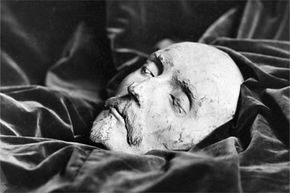Coming Alive: Death Masks in the Making
While not a truly medical practice, it was a physician who traditionally made the plaster mold of the recently deceased [source: Gibson]. A death mask needs to be made as soon after the person dies as possible -- in the first few hours after death, before bloating and the elements distort the character and expression on the face. Here's what the physician would do:
- Apply grease to the face and especially any facial hair, including eyebrows. Once the plaster dried, the grease prevented any hair from being ripped off of the face and allowed the bandages to release easily from the skin.
- Next, the doctor would layer plaster bandages mixed with water on the face. The first layer captured the details, even wrinkles, while the other layers reinforced the first.
- The plaster needed time to set. Modern plaster bandages dry in just a few minutes, but in previous centuries, the drying process took more than an hour.
- The doctor then carefully removed the hardened mold, or negative, from the face.
- Finally, the doctor poured a substance like wax or a metal such as bronze into the negative to make a positive, three-dimensional death mask.
One of these artifacts will last as long as the nature of the substance it is cast from -- a bronze mask, properly cared for, will last centuries. Wax, while more lifelike in tone, is much more susceptible to the elements.
Advertisement
For now, it seems that death masks are -- forgive the pun -- a dying art. But there is one death mask that has helped save countless lives ...
